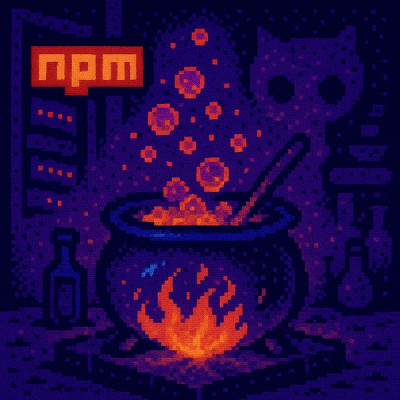
Research
/Security News
9 Malicious NuGet Packages Deliver Time-Delayed Destructive Payloads
Socket researchers discovered nine malicious NuGet packages that use time-delayed payloads to crash applications and corrupt industrial control systems.
hehe-maker
Advanced tools
A simple command line tool to modify papers in PDF format. Can also create new articles from PDF(s).
For an (outdated) guide in Swedish, as created for Redaktionen at E-sektionen, see README.swe.md
HeHE-maker is now capable of writing its' own articles! Check out the -aa flag for more information
HeHE-maker is a simple command line-tool to create a paper to be published in printed and/or web form. Simply create the pages you want, order them in an otherwise empty directory/folder (simply naming them 01.pdf, 02.pdf, 03.pdf etc. is enough) and let the script create printable versions, as well as web versions, for you! If more than one page happens to be in the same PDF-file, for example if an article has two pages in the same file, HeHE-maker will take care of this for you.
This program is part if the Python Package Index (PyPi) and can easily be installed and run using pip. Start by installing Python 3.x from here, and run python -v (or, in some cases, python3 -v) in your console and make sure everything looks reasonable. Then run the following commands:
pip install hehe-makerAlternatively
pip3 install hehe-makerDone! You can now use HeHE-maker by typing hehemaker followed by arguments (according to "Running the program" below)!
To check for updates, run pip install --upgrade hehe-maker
Update: Since version 1.3.13, HeHE-maker now supports direct paths; All functions can now be called on filepaths
Simply use hehemaker -i "<path to input>" -o "<path to output>" and the script will create print.pdf and web.pdf at the specified path. The path can either be full, like C:\\User\\...\\example or relative, or be omitted for HeHE-maker to default to the current directory.
If you are on Windows and this fails, check to see if Python and Python/Scripts are in your PATH-variables (Swe: Miljövariabler).
HeHE-maker can do much more to facilitate the publishing of a paper by using flags to set functions. These are written before the input and output paths. They are as follows:
-h or --help!-i and -o (or --input and --output respectively). For example, running hehemaker -o "C:\\Users\\<some user>\\Desktop" (note that quotes are optional) will assemble the pages in the current directory and output them to the desktop. These can be direct file paths, such as ~/somedir/example.pdf, but this will not work when using the --autoarticle or --get options or when using in normal mode (i.e. to create web and print-versions).-f or --force. (This is only necessary when running in normal mode, i.e. not using other flags)-g or --get and specify which pages you want.-s or --split.-rm or --remove followed by the page number(s) to be removed. Example: To remove the first and last page of a 12 page file, use hehemaker -rm 1 12 -i <path to input> -o <path to output>-ins or --insert followed by the path to the pages to be inserted, and -x (or --index) followed by where the pages should be inserted. Example: An article saved in "C:\Users\Hacke\..\article" is to be inserted at page 3. Use hehemaker -ins C:\\Users\\Hacke\\..\\article -x 3 -i <path to input>" -o <path to output>-aa or --autoarticle (and specify the number of sentances wanted, defaults to 40) and HeHE-maker will use the PDF files at the input directory to create a new article using computer magic and save it at the output directory. Note that this works best with a lot of samples! This can take a while (but still faster than writing the thing yourself! If I were you I would also go through the text and remove unforseen syntax errors (I am just a man and this script is just a burning pile of garbage). HeHE-maker can also extract files in the .txt format, and will create a .txt-file when done extracting from PDF(s). This way, -aa can be used on this text file instead in the future, speeding up the process!HeHE-maker is capable of using relative paths to find the directory/folder of your input/output. As default (i.e. no input and/or output is passed), HeHE-maker will set the current directory/folder as both input and/or output. For example, if all pages to a paper is saved in a folder at ~/Documents/HeHE. If we position ourselves in that directory and run hehemaker, we will create print.pdf and web.pdf in that ~/Documents/HeHE.
Little Timmy is a bit off his meds, and has not read the changelog. He can now use direct paths, for example ~./somedir/target.pdf instead of making folders directly. This can have unforseen (or just boring) consequences together with making a paper, there you should continue to use directories
Little Timmy has an old printed version of a paper as a PDF file, old.pdf, but he wants to censor the article on pages 4-5 and replace it with a two-page ad. He saves old.pdf in an otherwise empty directory ~./somedir/ and saves his ad in the (otherwise empty) directory ~./ad/.
Timmy starts by creating a web version by switching directory to ~./somedir/ and running hehemaker -s. He then removes old.pdf; ~./somedir/ now only contains split.pdf.
He now deletes the unwanted article, in accordance with his local Supreme Leader's wishes, by running hehemaker -rm 4 5. He then deletes all evidence by removing the old split.pdf.
He now inserts the ad (probably for his beloved Supreme Leader) by running hehemaker -ins ~./ad/ -x 4, and deletes the old removed.pdf.
Little Timmy now wants the whole paper in a printable format on his desktop, so he finally runs hehemaker -o C:\\Users\\TimmysMom\\Desktop.
Good job Timmy!
Doing all this with large documents (12+ pages) becomes very tiresome.
FAQs
A simple command line tool to modify papers in PDF format. Can also create new articles from PDF(s).
We found that hehe-maker demonstrated a healthy version release cadence and project activity because the last version was released less than a year ago. It has 1 open source maintainer collaborating on the project.
Did you know?

Socket for GitHub automatically highlights issues in each pull request and monitors the health of all your open source dependencies. Discover the contents of your packages and block harmful activity before you install or update your dependencies.

Research
/Security News
Socket researchers discovered nine malicious NuGet packages that use time-delayed payloads to crash applications and corrupt industrial control systems.

Security News
Socket CTO Ahmad Nassri discusses why supply chain attacks now target developer machines and what AI means for the future of enterprise security.

Security News
Learn the essential steps every developer should take to stay secure on npm and reduce exposure to supply chain attacks.